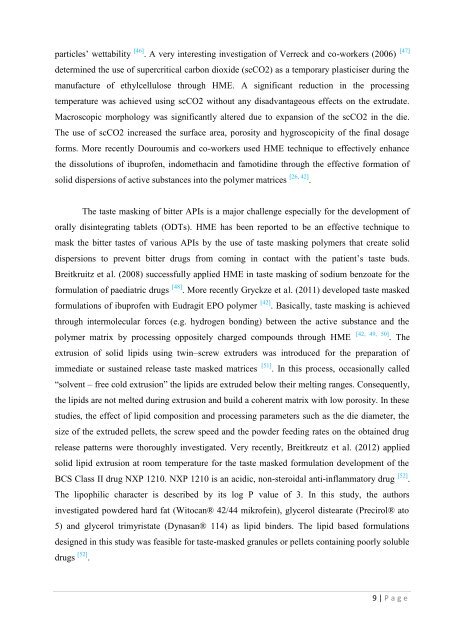Development of hot-melt extrusion as a novel technique for the ...
Development of hot-melt extrusion as a novel technique for the ...
Development of hot-melt extrusion as a novel technique for the ...
Create successful ePaper yourself
Turn your PDF publications into a flip-book with our unique Google optimized e-Paper software.
particles‘ wettability [46] . A very interesting investigation <strong>of</strong> Verreck and co-workers (2006) [47]determined <strong>the</strong> use <strong>of</strong> supercritical carbon dioxide (scCO2) <strong>as</strong> a temporary pl<strong>as</strong>ticiser during <strong>the</strong>manufacture <strong>of</strong> ethylcellulose through HME. A significant reduction in <strong>the</strong> processingtemperature w<strong>as</strong> achieved using scCO2 without any disadvantageous effects on <strong>the</strong> extrudate.Macroscopic morphology w<strong>as</strong> significantly altered due to expansion <strong>of</strong> <strong>the</strong> scCO2 in <strong>the</strong> die.The use <strong>of</strong> scCO2 incre<strong>as</strong>ed <strong>the</strong> surface area, porosity and hygroscopicity <strong>of</strong> <strong>the</strong> final dosage<strong>for</strong>ms. More recently Douroumis and co-workers used HME <strong>technique</strong> to effectively enhance<strong>the</strong> dissolutions <strong>of</strong> ibupr<strong>of</strong>en, indomethacin and famotidine through <strong>the</strong> effective <strong>for</strong>mation <strong>of</strong>solid dispersions <strong>of</strong> active substances into <strong>the</strong> polymer matrices [26, 42] .The t<strong>as</strong>te m<strong>as</strong>king <strong>of</strong> bitter APIs is a major challenge especially <strong>for</strong> <strong>the</strong> development <strong>of</strong>orally disintegrating tablets (ODTs). HME h<strong>as</strong> been reported to be an effective <strong>technique</strong> tom<strong>as</strong>k <strong>the</strong> bitter t<strong>as</strong>tes <strong>of</strong> various APIs by <strong>the</strong> use <strong>of</strong> t<strong>as</strong>te m<strong>as</strong>king polymers that create soliddispersions to prevent bitter drugs from coming in contact with <strong>the</strong> patient‘s t<strong>as</strong>te buds.Breitkruitz et al. (2008) successfully applied HME in t<strong>as</strong>te m<strong>as</strong>king <strong>of</strong> sodium benzoate <strong>for</strong> <strong>the</strong><strong>for</strong>mulation <strong>of</strong> paediatric drugs [48] . More recently Gryckze et al. (2011) developed t<strong>as</strong>te m<strong>as</strong>ked<strong>for</strong>mulations <strong>of</strong> ibupr<strong>of</strong>en with Eudragit EPO polymer [42] . B<strong>as</strong>ically, t<strong>as</strong>te m<strong>as</strong>king is achievedthrough intermolecular <strong>for</strong>ces (e.g. hydrogen bonding) between <strong>the</strong> active substance and <strong>the</strong>polymer matrix by processing oppositely charged compounds through HME [42, 49, 50] . The<strong>extrusion</strong> <strong>of</strong> solid lipids using twin–screw extruders w<strong>as</strong> introduced <strong>for</strong> <strong>the</strong> preparation <strong>of</strong>immediate or sustained rele<strong>as</strong>e t<strong>as</strong>te m<strong>as</strong>ked matrices [51] . In this process, occ<strong>as</strong>ionally called―solvent – free cold <strong>extrusion</strong>‖ <strong>the</strong> lipids are extruded below <strong>the</strong>ir <strong>melt</strong>ing ranges. Consequently,<strong>the</strong> lipids are not <strong>melt</strong>ed during <strong>extrusion</strong> and build a coherent matrix with low porosity. In <strong>the</strong>sestudies, <strong>the</strong> effect <strong>of</strong> lipid composition and processing parameters such <strong>as</strong> <strong>the</strong> die diameter, <strong>the</strong>size <strong>of</strong> <strong>the</strong> extruded pellets, <strong>the</strong> screw speed and <strong>the</strong> powder feeding rates on <strong>the</strong> obtained drugrele<strong>as</strong>e patterns were thoroughly investigated. Very recently, Breitkreutz et al. (2012) appliedsolid lipid <strong>extrusion</strong> at room temperature <strong>for</strong> <strong>the</strong> t<strong>as</strong>te m<strong>as</strong>ked <strong>for</strong>mulation development <strong>of</strong> <strong>the</strong>BCS Cl<strong>as</strong>s II drug NXP 1210. NXP 1210 is an acidic, non-steroidal anti-inflammatory drug [52] .The lipophilic character is described by its log P value <strong>of</strong> 3. In this study, <strong>the</strong> authorsinvestigated powdered hard fat (Witocan® 42/44 mikr<strong>of</strong>ein), glycerol distearate (Precirol® ato5) and glycerol trimyristate (Dyn<strong>as</strong>an® 114) <strong>as</strong> lipid binders. The lipid b<strong>as</strong>ed <strong>for</strong>mulationsdesigned in this study w<strong>as</strong> fe<strong>as</strong>ible <strong>for</strong> t<strong>as</strong>te-m<strong>as</strong>ked granules or pellets containing poorly solubledrugs [52] .9 | P a g e
















